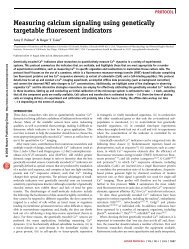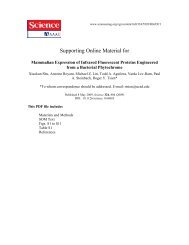THE GREEN FLUORESCENT PROTEIN - Tsien
THE GREEN FLUORESCENT PROTEIN - Tsien
THE GREEN FLUORESCENT PROTEIN - Tsien
Create successful ePaper yourself
Turn your PDF publications into a flip-book with our unique Google optimized e-Paper software.
522 TSIENincrease the intrinsic brightness of properly matured GFP molecules. Suchbrightness is measured by the product of extinction coefficient and fluorescencequantum yield (Table 1). The folding mutations merely increase the percentageof molecules that mature properly under adverse conditions, such as 37 ◦ C andhigh GFP concentrations that promote aggregation (33, 43–45). Although thefolding mutations are highly valuable and should be incorporated routinely intonew constructs, they produce less dramatic or no improvements at lower temperaturesand levels of expression. Also the increments in brightness achievedby compounding such mutations will be limited by the obvious fact that foldingcannot exceed 100% efficiency.The coexistence of neutral and anion chromophores giving two excitationpeaks in the wild-type spectrum has a few advantages and many disadvantagesfor cell biological applications. If the GFP fluorescence is to be detected by thenaked eye, UV excitation is convenient (40) because UV is inherently invisible.However, because intense UV can damage the eye, an external excitationblockingfilter would be advisable even for visual inspection. Also, scattering,autofluorescence, and the possibility of tissue damage are more severe with UVexcitation. Excitation at the 470-nm peak would reduce these problems but isinefficient because only 15% of the protein has the anionic chromophore thatabsorbs there. The photoisomerization is a major hindrance to quantitation ofimages, but it also permits the diffusion or trafficking of GFP-labeled proteinsto be monitored by locally irradiating a cell with a point or stripe of intenseUV and then imaging the subsequent fate of the photoisomerized protein with470-nm excitation (37).PHENOLATE ANION IN CHROMOPHORE (CLASS 2) GFPs with phenolate anionsin the chromophore have become the most widely used class for routine cellbiological use because they were the first group to combine high brightness withsimple excitation and emission spectra peaking at wavelengths very similar tofluorescein, the most popular small-molecule fluorophore. The most commonlyused mutation to cause ionization of the phenol of the chromophore is a replacementof Ser65 by Thr, or S65T (25), though several other aliphatic residues suchas Gly, Ala, Cys, and Leu have roughly similar effects (25, 46, 47). The triplemutation F64M, S65G, Q69L, found by random mutagenesis around the chromophore,has achieved considerable popularity under the name RSGFP4 (46).In both S65T and RSGFP4, the wild-type 395-nm excitation peak due to theneutral phenol is suppressed, and the 470- to 475-nm peak due to the anion isenhanced five- to sixfold in amplitude and shifted to 489–490 nm (25, 46, 48).The oxidation to the mature fluorophore was about fourfold faster in S65Tthan in the wild type (25). Like wild-type GFP, S65T folds fairly efficiently






